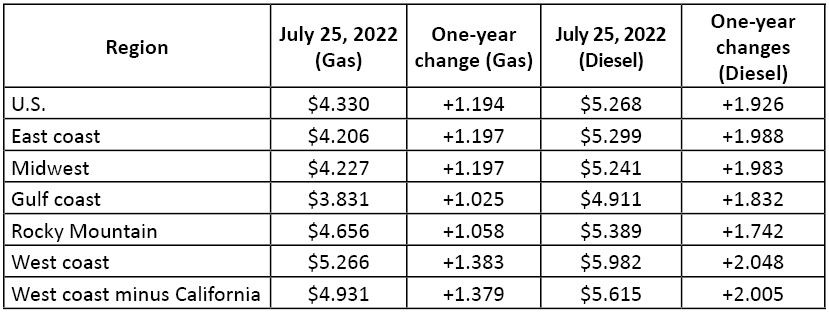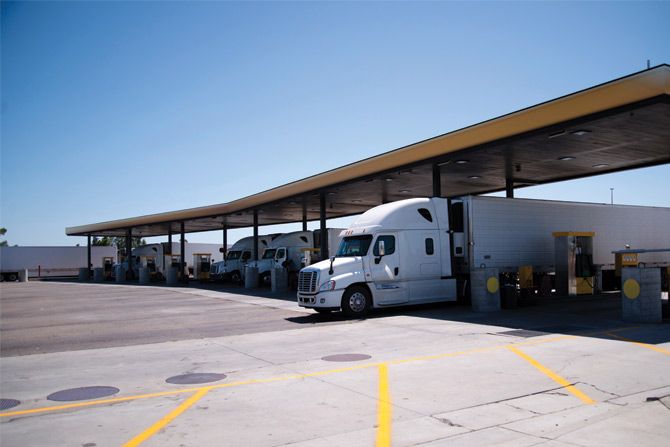Profit margins are crucial to running a successful business. In a competitive market when costs are higher than usual, it’s important to keep an eye on them.
You already know that diesel fuel prices are high. According to the U.S. Energy Information Administration July 25, 2022, a gallon of diesel in June 2022 cost $5.75. Of that $5.75, crude oil accounts for 47%, refining 29%, distribution and marketing 14% and taxes 10%.
The following table shows a few of the prices recorded July 25, 2022, along with the one-year price change. Gas and diesel are listed so you can see how much more expensive diesel is than gas and how much bigger the price hike is for diesel. Also, although Kentucky isn’t on the coast, it’s often grouped with east-coast states. Regardless, truckers travel everywhere in the continental U.S. and sometimes into other countries such as Canada or Mexico. They are likely to encounter a wide range of prices.

Semi-trucks have a capacity of 120-150 gallons. Experts recommend filling up to 95% of the total fuel capacity and never going below 25%. That means someone filling the tank when it is 25% full would need to buy 84-105 gallons of diesel and (if you use the U.S. average reported for July 25, 2022, and round down) spend more than $440-$550. Multiplying the number of gallons by the one-year increase for diesel, the cost is more than $160-$200 over what the same fuel would have cost a year earlier.
Regularly repeat the process — which must be done as part of the cost of doing business — and watch the profit margins go down. Alternatively, you can use the following techniques to improve your gas mileage, compensate for higher prices and increase profit margins.
Train Drivers About Efficient Driving Techniques
Acceleration: Since acceleration burns extra fuel, driving at a constant speed and avoiding acceleration as much as possible saves fuel. Strongly consider cruise control or adaptive cruise control, or anticipate acceleration points and accelerate as smoothly as possible. There’s a side benefit to avoiding surges of acceleration: it is easier on the engine.
Braking: Do what you can to avoid frequent, continuous braking. You lose energy every time you brake. Instead, maintain a good distance between your vehicle and whatever is ahead of you, and try to anticipate the need for slowing down. Also, pay attention to changing road conditions to avoid surprises.
Shifting: If you have to shift manually, you burn extra fuel every time because the RPMs increase. Minimize shifting, and when you do shift, try to shift while the RPMs are still low.
Speed: Once you reach over 60 mph, you use a tenth of a gallon more for every hour and every mile you drive. The fuel economy improves by 27% if a driver travels at 65 mph instead of 75 mph.
Idling: If you can reduce idling by 10% annually, you will improve fuel economy by 1%.
Invest in the Right Equipment
Check out the truck specs and buy trucks suited to the loads they haul. Invest in engines with high horsepower for heavy loads or use on rough terrain. And engines are easier on fuel if you haul lighter loads.
Telematics systems improve communication and can help you coordinate between drivers and fleet managers. The information you gain will give you information to reduce wasted fuel. For example, it can monitor drivers and emissions, verify fuel purchases and give you valuable feedback about truck operations.
EVs and hybrids can reduce fuel costs dramatically. There’s a big national push toward electrification; if you buy new equipment, consider what else is available besides a diesel engine.
Know and Maintain the Equipment
Preventive maintenance saves fuel. In addition to maintaining the engine, be sure to include the following:
- All engines have a sweet spot for the most efficient running speed. Find the correct RPM and drive accordingly.
- Regularly check any aerodynamic equipment to ensure nothing is dangling, dented, ripped or torn. Look at the tractor-to-trailer gap, too. Minimize it. Underbody trailer skirts can also help because they reduce wind drag during highway travel.
- Check the tire pressure regularly, especially since it is affected by hot or cold weather. Underinflated tires reduce fuel efficiency. If the tire pressure is 10 psi under what it should be, fuel consumption will be 0.5-1.0% higher.
- Monitor the diesel exhaust fuel. The exhaust will tell you whether the engine is working efficiently. Inefficient engines burn more fuel.
- Please pay attention to engine fault codes and deal with them promptly.
Plan Ahead
Before starting any road trip, map out the shortest route with the fewest stops. Also, pay attention to when you might encounter rush-hour traffic.
Check Gas Purchases
Make sure to monitor all fuel purchases made for each vehicle.
Conclusion
Diesel prices are high and experts agree these prices are here to stay for the near future. Consider some of the tips mentioned to achieve maximum use from every last drop of fuel purchased.









